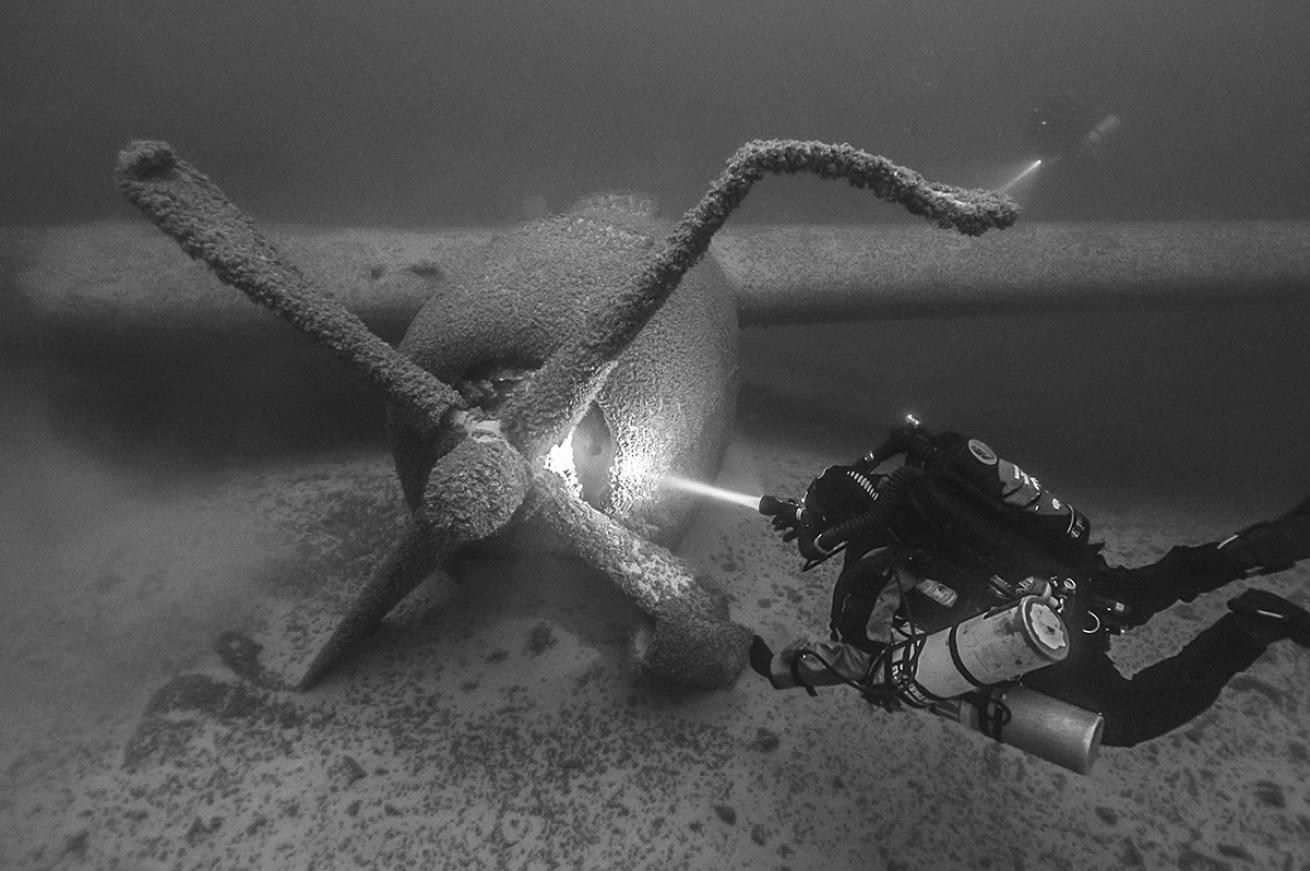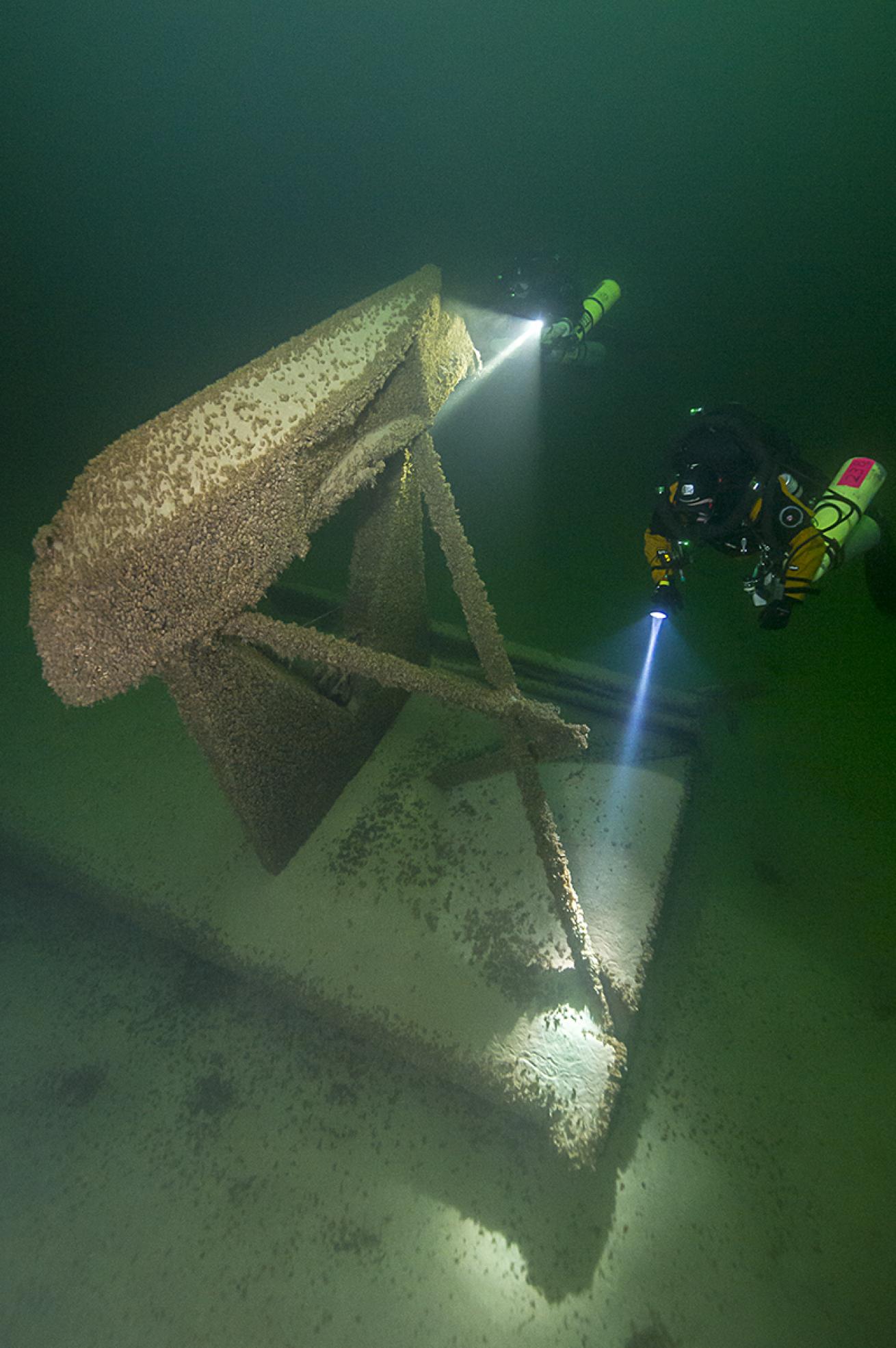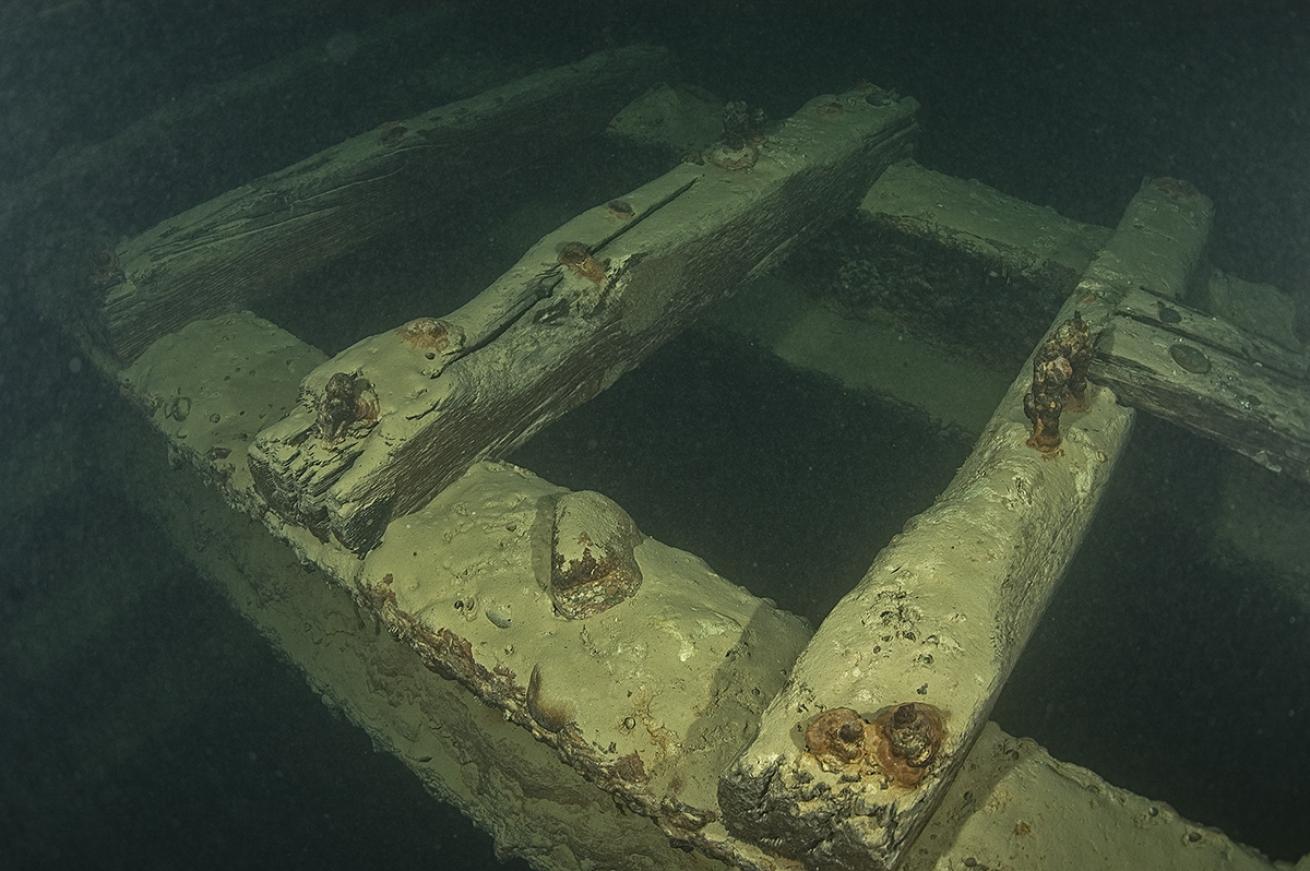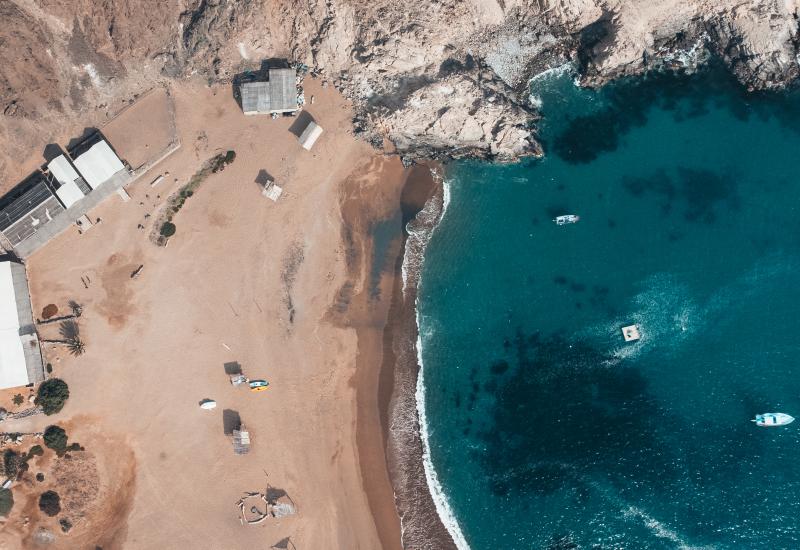Scuba Diving a B-29 Airplane Wreck in Lake Mead, Nevada

National Park ServiceIn Nevada, scuba divers examine the single remaining engine to Lake Mead's B-29 Superfortress.
My sinuses squeal in protest as I drop from a 120-degree inferno of desert heat to the 50-degree chill of the murky lake floor more than 100 feet below. Diving in the heart of the Mojave Desert is not for everyone — particularly in June, when in the span of a few minutes a diver can be ratcheted through a temperature swing of more than 70 degrees. But there’s something down there — something that was once a national secret — that remains one of the most interesting and intriguing dive sites in the country: a B-29 Superfortress airplane that crashed into Lake Mead at the dawn of the Cold War while doing high-altitude research.
With a few kicks I continue my descent, at once thankful for the cool water and unsettled by the fact that the bottom has yet to appear through the gloom. I inhale, exhale and trust that there is a bottom to this dive.
Hard by the glitzy haze of Las Vegas, Lake Mead National Recreation Area is an unappreciated but spectacular dive destination. Beneath this liquid affront to the arid Mojave lie undiscovered jewels for the intrepid and quirky few who are willing to drive and dive there. Accessible year-round and home to some truly unique underwater sites, a dive trip to Nevada is definitely an unusual brag to roll out on your diving buddies; yet with a little planning and a little moxie, Lake Mead delivers a world-class set of diving adventures.
In 1948, 26-year-old pilot Robert Madison took his modified B-29 Superfortress with a crew of four others on a low-level pass over the northern Overton Arm area of the lake. The B-29, an aircraft most commonly associated with the atomic attacks on Hiroshima and Nagasaki, was ideal for testing advanced technologies and data collection once its wartime uses ended. Madison’s mission was classified at the time of the crash, but the tissue of secrecy has frayed over the decades passed, and we now know that the plane was carrying a prototype guidance system to be used on the then-unproven technology of intercontinental ballistic missiles.
As Madison roared over the lake in his four-engine bomber, he misjudged his height and struck the waters with a glancing blow. The shock of impact wrenched three of the four engines from the plane. With the fourth and final engine on fire, Madison ditched into the lake; all five crew scrambled to safety before the bomber disappeared into the depths. The only injury was a broken arm.

National Park ServiceNEVADA WRECK DIVING
An upside-down outrigger pontoon marks Lake Mead's PBY-5A Catalina flying boat.
In 2001, local divers discovered the lost plane; in 2007 the National Park Service set up and opened the site to guided dives for the adventurous few. The site is accessed by a down line on a buoy, with a crossover line laid out for almost 80 feet across a silty bottom to the plane itself. Approaching along the line, you see the base of the tail and then you look up — and up and up — and realize that, damn, this is really a humongous aircraft. This is one of those dives to sit back and enjoy: Take some time, get your buoyancy right, and really take in the sleek lines of the bullet-shaped plane.
When divers first started visiting the site, it was more than 200 feet deep, a challenging technical dive. Now, in the face of a huge regional drought, lake levels have dropped precipitously — bad for hydropower but great for access. In summer 2015, the B-29 was less than 120 feet deep; other Lake Mead sites get deeper or shallower as the reservoir fills and empties over the year. A question you get used to asking locals when planning your dives is, ”How deep is the site this week?”
As amazing as diving a sunken Cold War warrior might be, there are several other sites hidden beneath the waters of the lake. In the relatively accessible and shallow depths of the Boulder Basin area of the huge lake lie the remains of a massive industrial facility that was key to the construction of Hoover Dam — the Aggregate Washing and Sorting Facility, known locally as the Agg Plant. At the time of its construction in 1931, the plant was the largest, most advanced factory of its kind in the world. Entire trainloads of sand and gravel were dumped on a series of conveyor belts, sorted and used to build the dam — more than 6.5 million tons of aggregate and cement. Almost 100 years later, the concrete in the dam’s core is still curing.
Diving what remains of the Agg Plant is a little post-apocalyptic, only without the zombies. Sections of tracks, concrete foundations and walls, track beds, tunnels and huge piles of sorted aggregate sprawl over more than eight acres of lake floor, detritus of a massive indus- trial undertaking now long forgotten. The local dive community has laid cave lines all over the site, leading a diver from one discovery to another, on a historical Easter-egg hunt of twisted, rusting machinery and train-track beds. In terms of wow factor, it’s not the B-29, but to add another brag for the folks back home, how many of your scuba diving buddies have dived an underwater factory?
Finally, for those with a little more experience and training in technical diving, the remains of another aircraft, a PBY-5A Catalina flying boat, also lies in Boulder Basin, close to the Agg Plant.

National Park ServiceSections of train tracks mark the ghostly remains of the huge Aggregate Washing and Sorting Facility in Lake Mead, Nevada.
The plane — surplus from WWII, modified for civilian use — crashed while attempting a water landing in 1949; tragically, four of the five crew died. A descent here is indeed disconcerting, and you have to remind yourself that this lake has a bottom and, yes, you will get there before you run out of air.
As with the B-29, the initial approach to the plane over the bottom leads to one of the seaplane’s massive outrigger pontoons, lying upside down in the murk and as big as a small sailboat. Over the years, the fabric that covered the flaps and rudder has decayed and disappeared; although the plane is smashed and disarticulated into two principal pieces, enough distinct pieces of recognizable aircraft, like landing wheels, remain to offer a sense of the size and majestic nature of this amazing piece of aviation history.
With some remarkable dives and the stories that come with them, this region offers a mixture of quaint and quirky that will push you to be a better diver, to take an interest in history and, as your gear dries in Boulder City at the end of your adventure, to watch the play of light on the mountains that rim the lake and be thankful that there is something in our lives called scuba diving.
DIVING IN NEVADA: WHAT YOU NEED TO KNOW
When To Go: Diving is possible year-round, but June, July and August are brutally hot, which makes donning a drysuit or 7 mm for the chilly 50-degree water temps an ordeal. For best viz, dive March through May; October and November are more pleasant.
Diving Conditions: Tech Diving Limited requires that all divers have Advanced Open Water and Nitrox, plus proof of 50 dives. A recommended equipment list is at divetheb29.com. Depths vary with the amount of water in the reservoir; check with TDL or other local dive shops like Sin City Divers for the latest conditions. To calculate depths, subtract site elevations from current lake levels as published online by the Bureau of Reclamation (B-29, 960 feet; Agg Plant, 1,000 feet; PBY, 930 feet).
Operators: Currently TDL is the sole operator licensed by the National Park Service to guide dives on the B-29. However there are several other outfitters that provide guided diving and instruction at Lake Mead. Check Lake Mead National Park’s website at for a list of approved guides and instruction services.
ITINERARY: NEVADA SCUBA DIVING
Day 1: If you want to get serious about diving in the shadow of Sin City, book a quiet, inexpensive room in the quaint small town of Boulder City, gateway to Lake Mead. Historic motor motels like the El Rancho are clean and friendly, and provide great access to old-town Boulder City. Walk into town and enjoy sidewalk dining at Milo’s Cellar or a locally brewed beer from the Boulder Dam Brewing Company, then get a good night’s sleep and congratulate yourself that you’re not in Vegas.
Day 2: It’s going to be a long day on the water, so fuel up at The World Famous Coffee Cup. The Cup, as it’s known by locals, opens every day at 6 a.m. Don’t take too much time talking to the regulars because you have an hour drive to meet the boat from Tech Diving Limited at 7:30 at Echo Bay Marina on the remote Overton Arm of Lake Mead.
Day 3: It would be a mistake to leave Lake Mead without diving the Agg Plant. If you are self-confident, you can hire a boat from Lake Mead Marina, or you can charter for a second day. After two days of diving, take a congratulatory lap around the Las Vegas strip, have a nice dinner, and maybe take in Cirque Du Soleil’s Aquatic O at the Bellagio.










